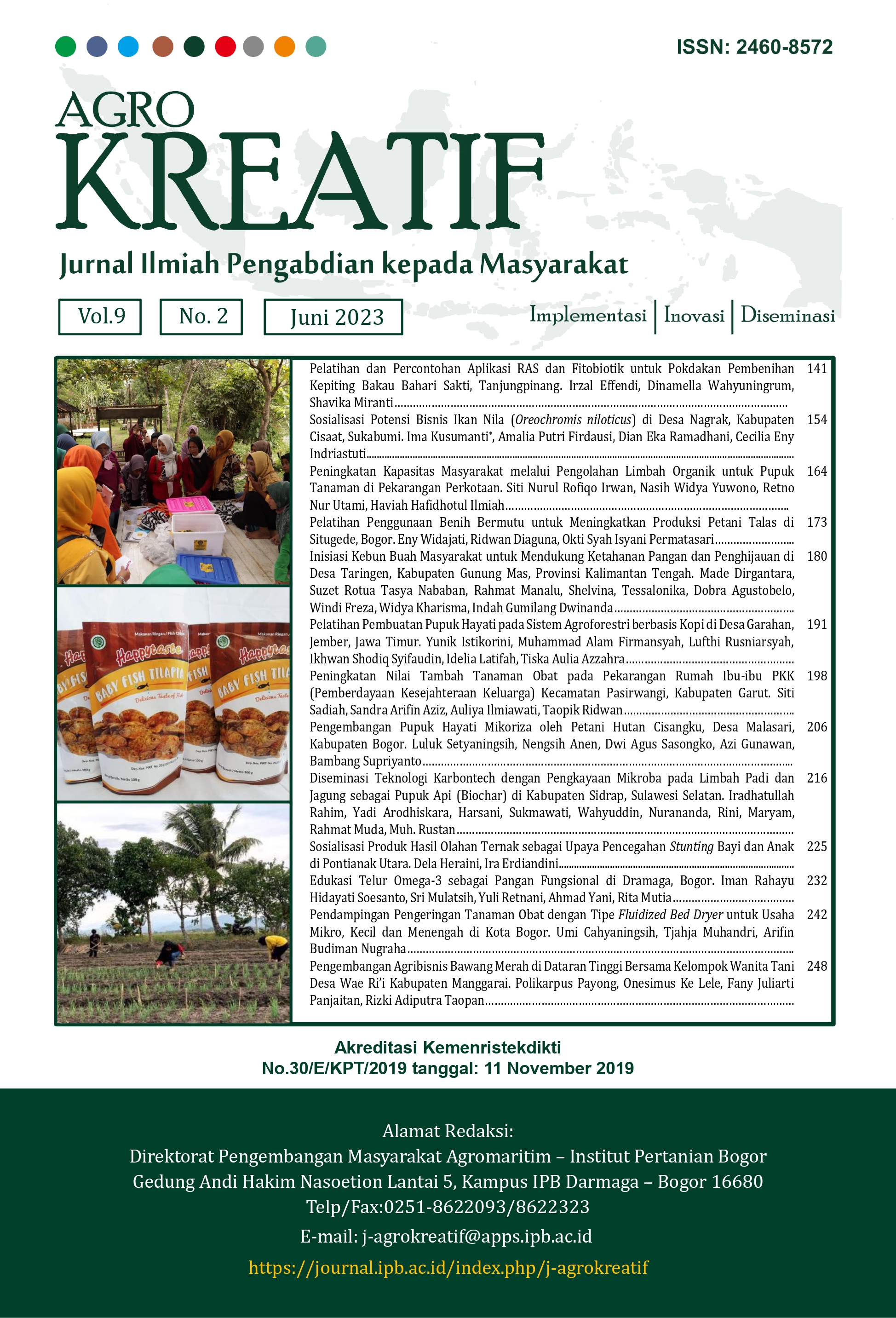Pengembangan Pupuk Hayati Mikoriza oleh Petani Hutan Cisangku, Desa Malasari, Kabupaten Bogor
Abstract
The success of revegetation in the context of forest land rehabilitation and post-mining land reclamation is often often caused by constraints due to marginal land conditions, such as high acidity/alkalineity, low organic matter content, and low availability of macro nutrients. Mycorrhiza Biofertilizer (MB) is one alternative technology that has been reported to be able to increase the success of the rehabilitation. Forest farmers, as one of the actors in forest rehabilitation activities, do not yet have sufficient knowledge and skills in developing biofertilizer such as MB. The objectives of theis community services were to introduce and improve forest farmer about the MB, as well as to establish the demonstration plot for MB development. The result showed that field training and counseling on mycorrhiza and its benefits, as well as the manufacture of mycorrhizal biofertilizers have been carried out in Cisangku, Malasari village, Bogor Regency involving Forest Farmers Model Conservation Village (KTH MKK). The counseling and training were attended by 25 forest farmer participants. Based on the postest carried out after the implementation of counseling and training, there was an increase in farmers' knowledge about mycorrhizal and its benefits as well as procedures for developing mycorrhizal fertilizers. The participants wer also satisfied and increased their skill in preparing mycorrhizal culture materials and caring for their selves. The participating farmers were even willing to develop MB independently if they have sufficient skills and know the benefits. The increasing knowledge and skills of forest farmers had an impact on improving the quality of forest farmers in supporting forest rehabilitation and becomes an alternative of additional income.
Downloads
References
Bakhtiar Y, Yahya S, Sumaryono W, Sinaga MS, Budi SW, Tajudin T. 2010. Isolation and identification of mycorrhizosphere bacteria and their antagonistic effects towards Ganoderma boniense in vitro. Journal of Microbiology Indonesia. 4(2): 96‒102. http://dx.doi.org/10.5454/mi.4.2.9.
Duponnois R, Colombet A, Hien V, Thioulouse J. 2005. The mycorrhizal fungus Glomus intraradices and rock phosphate amendment influence plant growth and microbial activity in the rhizosphere of Acacia holosericea. Soil Biology & Biochemistry. 37(8): 1460–1468. https://doi.org/10.1016/j.soilbio.2004.09.016
Hartoyo APP, Nafis MK, Natasya N, Ulfah K, Ariyana SE, Raihan F. 2022. Pembentukan Rumah Vegetatif Tanaman Hias Sebagai Wadah Pemberdayaan Ibu Rumah Tangga Desa Sipungguk, Kabupaten Kampar, Riau. Agrokreatif Jurnal Ilmiah Pengabdian kepada Masyarakat. 8(2): 137145. https://doi.org/10.29244/agrokreatif.8.2.137-145
Hause B, Fester T. 2005. Molecular and cell biology of arbuscular mycorrhizal symbiosis. Planta 221: 184–196. https://doi.org/10.1007/s00425-004-1436-x
Medina MJH, Steinkellner S, Vierheilig H, Bote JAO, Garrido JMG. 2007. Abscisic acid determines arbuscule development and functionality in the tomato arbuscular mycorrhiza. New Phytologist. 175(3): 554–564. https://doi.org/10.1111/j.1469-8137.2007.02107.x
Herryawan KM. 2019. Perbanyakan Inokulum Fungi Mikoriza Arbuskular (FMA) secara sederhana. Pastura 2(2): 57‒60.
Peraturan Mentri Lingkungan Hidup dan Kehutanan Republik Indonesia No P.89/MENLHK/SETJEN/KUM.1/8/2018 tentang Pedoman Kelompok Tani Hutan.
Wahyuni RP, Sudibyo RP, Ocvanny NA. 2021. Faktor-Faktor yang Berperan Terhadap Tingkat Partisipasi Petani dalam Budi daya Tanaman Organik di Kecamatan Junrejo Kota Batu Jurnal Ekonomi Pertanian dan Agribisnis (JEPA). 5(2): 544‒560. https://doi.org/10.21776/ub.jepa.2021.005.02.22
Rotor AV, Delima PC. 2010. Mycorrhizal association, N fertilization and biocide application on the efficacy of bio-N on corn (Zea mays. L) growth and productivity. Journal of Scientometric Research. 2(3): 267‒290.
Setyaningsih L, Wulandari AS, Hamim H. 2018. Growth of typha grass (Typha angustifolia) on gold-mine tailings with application of arbuscular mycorrhiza fungi. Biodiversitas. 19(2): 454‒459. https://doi.org/10.13057/biodiv/d190218
Setyaningsih L, Setiadi Y, Budi SW, Hamim, Sopandie D. 2017. Lead accumulation by jabon seedling (Anthocephalus cadamba) on tailing media with application of compost and arbuscular mycorrhizal fungi. ISSIOP Confrence Series: Earth and Environmental Science 58 (2017) 012053. https://doi.org/10.1088/1755-1315/58/1/012053
Setyaningsih L, Haneda NF, Hamim. 2021. Pupuk Hayati Fitoremedian. Indonesia. IDS000003690. Paten Sederhana.
Setyaningsih L. Hamim, Maslahat M. 2021. Remediasi Timbal pada Media Tailing dengan Pemanfaatan Tanaman Hutan dan Fungi Mikoriza Arbuskula. Indonesia. IDS000003691. Paten Sederhana
Setyaningsih L, Didakyatama FA, Wulandari AS. 2020. Arbuscular mycorrhizal fungi and Rhizobium enhance the growth of Samanea saman (trembesi) planted on gold-mine tailings in Pongkor, West Java, Indonesia. Biodiversitas. 21(2): 611‒616. https://doi.org/10.13057/biodiv/d210224
Suhardjadinata, Kurnia F, Lulu DHN. 2020. Pengaruh Inokulasi Cendawan mikoriza arbukular dan pupuk NPK terhadap pertumbuhan dan hasil tomat (Lycopersicum esculentum Mill.). Media Pertanian. 5(1): 20‒30. https://doi.org/10.37058/mp.v5i1.2131
Budi SW, Setyaningsih L. 2013. Arbuscular Mycorrhizal Fungi and Biochar Improved Early Growth of Neem (Melia azedarach Linn.) Seedling Under Greenhouse Conditions. Jurnal Manajemen Hutan Tropica. XIX(2): 103‒110. https://doi.org/10.7226/jtfm.19.2.103
Budi SW, Christina F. 2013. Coal Waste Powder Amendment and Arbuscular Mycorrhizal Fungi Enhance the Growth of Jabon (Anthocephalus cadamba Miq) Seedling in Ultisol Soil Medium. Journal Tropical Soil. 18(1): 59‒66
Wu QS, Zou YN, He XH. 2010. Exogenousputrescine, not spermine or spermidine, enhances root mycorrhizal development and plant growth of trifoliate orange (Poncirus trifoliata) seedlings. International Journal of Agriculture and Biology. 12(4): 576–580
Yusrizal, Muyassir, Syafruddin. 2018. Optimalisasi tanah kritis dengan mikoriza dan fosfat untuk peningkatan pertumbuhan dan serapan hara kedelai. Jurnal Agrotek Lestari. Vol. 4(1): 100‒112. https://doi.org/10.35308/jal.v4i1.641
This work is licensed under a Creative Commons Attribution-NonCommercial 4.0 International License.
10.53769/jai.v4i4.1083



















